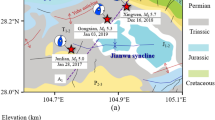Abstract
The current research focused on characterizing sub seismic reservoirs in the Nile Delta and applies the spectral decomposition technique to delineate the direct hydrocarbon indicators (DHI’s) from the low-frequency shadow (LFS) anomalies and can use the spectral decomposition as a direct hydrocarbon indicator in El Mansoura area, Onshore Nile Delta, hence, it can provide a supplementary technique alongside the more widely used amplitude and amplitude versus offset (AVO) anomalies. The study has been applied for certain selected wells, focusing on analyzing the differently constructed frequency cubes and monitoring the responses of high and LFS anomalies, using the different algorithms of the spectral decomposition technique. The full stack 3D seismic data were imported and decomposed, using the continuous wavelet transform method and separated into several frequency cubes, ranging from 10 to 45 Hz, every 5 Hz interval. The time window used for checking the LFS, in the seismic sections is usually about 200 ms below the pay zone. The results show that, the low-frequency anomalies can be used in a sand/shale sequence very well, and in particular, can de-risk the prediction for a thick gas-bearing reservoir, when used in conjunction with the other DHI’s such as the AVO. The low-frequency anomaly can be generated by a thick limestone/shale sequence, particularly by the multiple layers of limestone.





























Similar content being viewed by others
References
Abdel Halim M (2001) Future hydrocarbon potential in the Nile Delta offshore and onshore. In: Zaghloul ZM, El-Gamal M (eds) Deltas modern and ancient. Proceedings of 1st international symposium on the Deltas, 13–19 March 1999, Cairo, Egypt, pp 159–174
Babalola A (2013) Resolution of sub-seismic reservoirs by the application of spectral decomposition and spectral inversion methods in Boonsville field, North Central Texas. Master Thesis, University of Houston
Barnes AE (1993) Instantaneous spectral bandwidth and dominant frequency with applications to seismic reflection data. Geophysics 58:419–428
Burnett M, Castagna JP, Méndez Hernández E, Ziga Rodríguez G, Figón García L, Martínez Vázquez J, Téllez Avilés M, Vila Villaseñor R (2003) Application of spectral decomposition to gas basins in Mexico. Lead Edge 22:1130–1134
Castagna JP, Sun S (2006) Comparison of spectral decomposition methods. First Break 24:75–79
Castagna J, Sun S, Siegfried R (2003) Instantaneous spectral analysis: detection of low-frequency shadows associated with hydrocarbons. Lead Edge 22:120–127
Chakroborty A, Okaya D (1995) Frequency-time decomposition of seismic data using wavelet based methods. Geophysics 60:1906–1916
Chopra S, Marfurt KJ (2006) Seismic attribute mapping of structure and stratigraphy. Society of Exploration Geophysicists, Tulsa
Chopra S, Castagna JP, Portniaguine O (2006) Seismic resolution and thin-bed reflectivity inversion. CSEG Rec 31:19–25
Chuang H, Lawton DC (1995) Frequency characteristics of seismic reflections from thin beds. Can J Explor Geophys 31:32–37
Claerbout JF (1976) Fundamentals of geophysical data processing. Blackwell Scientific Publications, Hoboken
Cohen L (1995) Time-frequency analysis. Prentice Hall Inc, Upper Saddle River
Dilay A, Eastwood J (1995) Spectral analysis applied to seismic monitoring of thermal recovery. Lead Edge 14(11):1117–1222
EGPC (Egyptian General Petroleum Corporation) (1994) Nile Delta and North Sinai: field discoveries and hydrocarbon potentials (A comprehensive overview). Egyptian General Petroleum Corporation, Cairo
Fahmy WA, Matteucci G, Butters D, Zhang J, Castagna J (2005) Successful application of spectral decomposition technology toward drilling of a key offshore development well. SEG Tech Progr Expand Abstr. https://doi.org/10.1190/1.2144316
Ghaly A, Khalil A, Mahmoud A (2013) Stratigraphic analysis and petroleum exploration, offshore Nile Delta. Egypt 28:1–20
Kamel H, Eita T, Sarhan M (1998) Nile delta hydrocarbon potentiality, Egypt. In: Proceedings of the 14th EGPC exploration and production conference, Cairo, Egypt, vol 1, pp 485–503
Laughlin K, Garossino P, Partyka G (2002) Spectral decomposition applied to 3D. AAPG Explor 23(5):28–31
Marfurt KJ, Kirlin RL (2001) Narrow-band spectral analysis and thin-bed tuning. Geophysics 66:1274–1283
Odebeatu E, Zhang J, Chapman M, Liu E, Li X (2006) Application of spectral decomposition to detection of dispersion of anomalies associated with gas saturation. Lead Edge 25(2):206–210
Olowokere MT, Abiola O, Ojo JS (2017) Seismic attribute analysis and reservoir characterization of “George’’ field, offshore Niger Delta Nigeria. IJRDO J Appl Sci 3(4):3
Partyka GA (2001) Seismic thickness estimation: three approaches, pros and cons. In: 70th Annual International Meeting Society of Exploration Geophysicists, Expanded Abstracts, pp 503–506
Partyka G, Grindley J, Lopez J (1999) Interpretational applications of spectral decomposition in reservoir characterization. Lead Edge 18(3):353–360
Rizzini A, Vezzani F, Coccocetta V, Milad G (1978) Stratigraphy and sedimentation of neogene-quaternary section in the Nile Delta area, (A.R.E). Mar Geol 27:327–348
Robertson JD, Nogami HH (1984) Complex seismic trace analysis of thin beds. Geophysics 49:344–352
Ross D, Uchupi E (1977) Structure and sedimentary history of northeastern Mediterranean Sea—Nile cone area. AAPG Bull 61:872–902
Said R (1962) The geology of Egypt. Elsevier, New York
Sinha S, Routh R, Anno P, Castagna J (2005) Spectral decomposition of seismic data with continuous-wavelet transform. Geophysics 70:19–25
Taner MT, Koehler F, Sheriff RE (1979) Complex seismic trace analysis. Geophysics 44:1041–1063
Wang Y (2012) Reservoir characterization based on seismic spectral variations. Soc Explor Geophys Geophys 77(6):M89–M95
Webster G, Levin F (eds) (1978) Deconvolution, geophysics. Reprint Series No. 1. Society of Exploration Geophysicists, Tuls
Widess MB (1973) How thin is a thin bed. Geophysics 38:1176–1180
Yang M (2003) Monochromatic AVO: an indicator that sees through wave interference. In: 73rd annual international meeting SEG, Expanded Abstracts, 208--210. https://doi.org/10.1190/1.1817746
Yilmaz Ö (2001) Seismic data analysis: SEG investigations in geophysics No. 10
Acknowledgements
The authors would like to extend their sincere appreciation and great thanks to the Egyptian Natural Gas Holding Company (EGAS), Petroceltic-International Plc and El Mansoura Petroleum Company for all their support during the production of this current work.
Author information
Authors and Affiliations
Corresponding author
Additional information
Publisher's Note
Springer Nature remains neutral with regard to jurisdictional claims in published maps and institutional affiliations.
Rights and permissions
About this article
Cite this article
Abu El-Ata, A.S., El-Behiry, M.G. & Hussein, M. Applications of the frequency analysis, using the spectral decomposition in the reservoir characterization. Geomech. Geophys. Geo-energ. Geo-resour. 5, 457–478 (2019). https://doi.org/10.1007/s40948-019-00118-z
Received:
Accepted:
Published:
Issue Date:
DOI: https://doi.org/10.1007/s40948-019-00118-z




